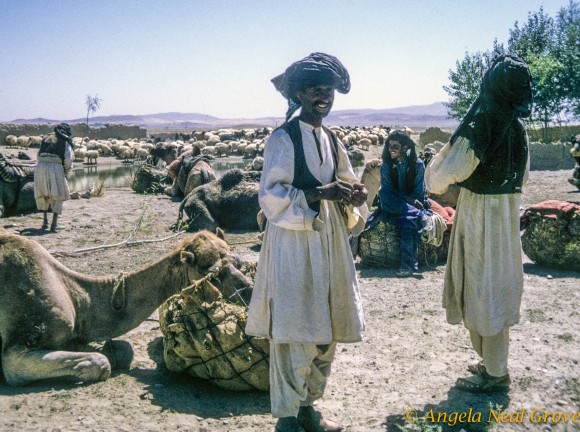
For thousands of years nomads lived freely in Central Asia and the Steppes. Their lifestyle was surprisingly ordered. They would move with their flocks as conditions dictated, when pastures became overgrazed or seasons changed. Now their centuries-old way of life is almost gone, devastated by years of war and conflict.
In the mid-seventies I joined a bus traveling overland across Asia. While traveling in Afganistan we met Kochi nomads. The memory is both warm and vivid…
Kochis on the Road to Kandahar
…Black tents were clustered near a wadi or dry riverbed. They belonged to Kochi, Afghan nomads who have lived a life on the move for thousands of years. We slowed the bus. It was a hot afternoon. We had finished our picnic lunch of flat bread, cheese and ripe juicy melon about an hour ago and were in rest mode. The camp looked quiet, but children had seen us and were running towards the road.

We stopped and opened the door. For some reason I had not expected to see Kochi so soon after leaving Herat, still close to the Iranian border. The contrast between Iran during Shah’s regime with its Western lifestyle, air-conditioning and smooth roads and Afghanistan was extraordinary. At the border I had watched an Afghan official slurp water from a goatskin as he minutely examined every page of my passport. A few nights before we had been eating Caspian Sea caviar in Tehran.
The children had almost reached us. We clambered from the bus. They motioned us to follow across the wadi and up the rocky bank towards the tents. They were smiling, excited, and very energetic. We scrambled to keep up. My sandals sliped on the loose stones.
Inside the Tents
In the first tent was a young woman with a small child in her arms. She smiled at us, dark eyes shining under a crop of jet black hair. Her colorful scarf, worn loosely over her head, was decorated with silver beads and discs. They clinked melodically as she moved. The black tent was low, wide and made of woven goat hair. The sides were rolled up and it felt cool on the hot afternoon. The floor was bare and there was little except a cooking pot and a worn kettle.
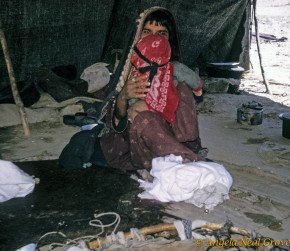
One of the children tugged at my arm, I thanked the woman for her hospitality – for inviting us into her home. We were lead to another tent. There two men reclined against a pile of handwoven jewel-toned wool rugs.
Cigarettes, Barter for the Bazaar
The men did not seem to mind us invading their world though they eyed us cautiously. I had been advised to take cigarettes as gifts and had Dunhills in signature burgundy and gold wrapping. I gave a pack to each of the men. One of them looked at it thoughtfully, carefully turning it over. In retrospect it seems an innappropriate gift. If he smoked I am sure it was something locally grown but maybe he was able to sell the pack in the bazaar. At the time it seemed okay and they nodded their thanks.
Where Were They Going?
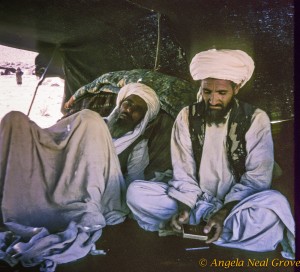
This was clearly a very temporary stop. They were on the move. Perhaps they were going to Jelhum in Pakistan, through the Khyber Pass. There grazing would be good after summer monsoons. In Spring after snow melt they would return to mountain pastures. This pattern is an ancient, and sustainable, way to cope with climate and feed huge flocks of sheep. For centuries nomadic people moved across Central Asia, crossing the broad sweep of the Steppes and mountain ranges regardless of man-made boundaries. Afghanistan was historically a hub for the routes and trails which made up the Ancient The Silk Road.
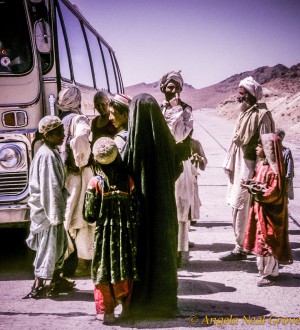
A Nomad Crown and Afghan Kings
To some the nomadic lifestyle may appear simple. In fact these people have a rich heritage. A Golden crown, over 4,000 years old, was found by Afghan farmers in 1966. It is part of a treasure trove named the Bactrian Hoard which includes over 22,000 artifacts. It was, according to the Washington Post, “one of the greatest archeological discoveries of the 20th century,”.
Following this discovery National Geographic partnered with the National Museum of Afghanistan to take some of the treasures on a world tour. On the cover of the official guide book is a photograph of the gold crown. Besides its beauty and intricate workmanship this nomadic crown was clearly designed for a life on the move. It can be dismantled and easily transported.
Impounded Passport and a New Era
Now times have changed. As I sat with those wonderful people that afternoon did they have any idea the life they had always known was coming to an end? The King, deposed in 1973, was the same ethnic tribe as the Kochis. As long as he was in Kabul, Kochis had freedom in Afghanistan – even crossing the border into Pakistan without passports.
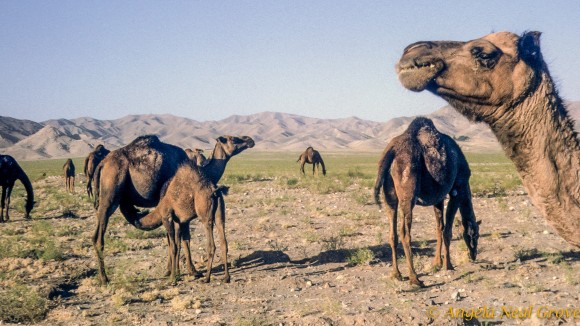
The regime change had even affected me. I applied for a visa at the Afghan Embassy in London. The coup d’etat happened while it was there. I retreived my passport. The visa stamped “Royal Afghan Embassy ” was cancelled. In Tehran I finally got a valid visa. The “Royal” section was blanked out.
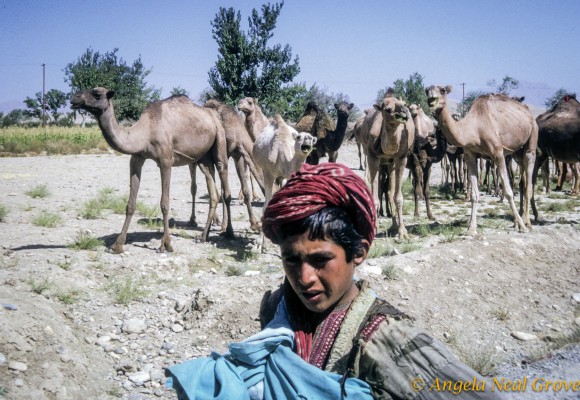
Future invasions and conflict, however, were far from our thoughts that afternoon sitting on the ground in the tents. These were lovely gracious people who welcomed complete strangers into their homes. It is something I shall never forget. Later on along the road to Kabul, near Ghazni I saw another group of Kochi stopped at a watering hole. The tall men were laughing and relaxed. Camels were resting, and there were hundreds of fat tailed sheep. I had been reading James Michener’s Caravans a tale of an American woman who travels with nomads. As I stood there the book almost came alive.
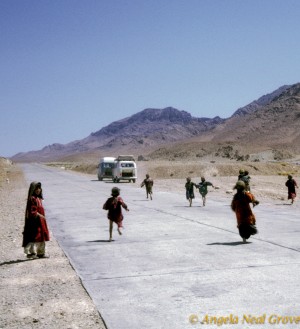
Romance and Hardship
There is no doubt that, for me and many, the life of nomads has a romantic aura. There is the freedom to travel across boundaries, to set off at sunrise and walk fifteen or more miles before setting up camp. Also the cameraderi of the caravan. But this is not a lifestyle which translates to the 21st century. For Kochi without a royal protector, Russian invasion and the strife and war which followed made their lifestyle impossible. Some fled, many were killed by landmines and those who survived are marginalized. They do not have passports, most are illiterate, their grazing pastures are gone and most were forced to sell their flocks.
I treasure the brief time I spent with them. The memories are haunting and beautiful and all that remains.
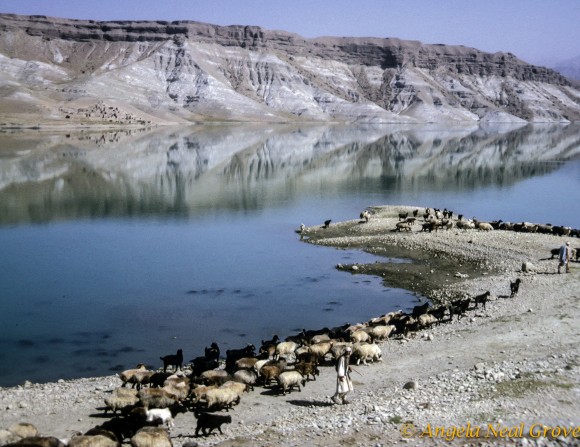
How wonderful to bring the past current, regardless of the reality. how alive your writing is bringing us to a place few have seen. Now I want to go there!
thank you.
This piece was written after giving a recent talk on traveling overland across Asia. In an thank you letter from the organizer she wrote, “Thank you for anchoring a piece of time which is now gone, or different – it was haunting and beautiful.” She could not have said it better – it was haunting and beautiful and my heart now aches for those wonderful people I met
I too wish I could go back in time and visit this part of the world. Thank you Angela for bringing it so alive for us!
I love sharing the memories
So happy to go down memory lane with you. The article and pictures are amazing.
All your trips should be shared, as you write so beautifully. Thanks for sharing.
So happy you liked it. Amazing how well the photographs have survived